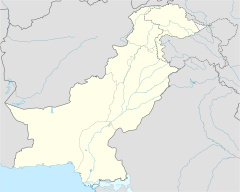Okara, Pakistan facts for kids
Quick facts for kids
Okara
اوکاڑہ
|
|
|---|---|
|
The shrine of Khoo Pak, Company Bagh
|
|
|
Location in Punjab, Pakistan
|
|
| Country | |
| Province | |
| Division | Sahiwal |
| District | Okara |
| Area | |
| • Metro | 4,377 km2 (1,690 sq mi) |
| Elevation | 105 m (344 ft) |
| Population
(2023 census)
|
|
| • City | 533,693 |
| • Rank | 25th, Pakistan |
| Time zone | UTC+5 (PST) |
| Postal code |
56300
|
| Area code | 044 |
| Highways | |
| Number of Union councils | 140 |
Okara (Punjabi, Urdu: اوکاڑہ), is the capital city of Okara District in the Punjab province of Pakistan. The name Okara is derived from Okaan, which is the name of a type of tree. In ancient times there were a large number of Okaan trees, which is why the area was named Okara. It is the 23rd largest city of Pakistan by population. The city is located southwest of the city of Lahore and Faisalabad is 100 km bypassing the Ravi River. It is known for its agriculture-based economy and cotton mills. The nearest major city to Okara is Sahiwal, which was formerly known as Montgomery. Kasur is also located in the east of the city. Pakistan military dairy farms, known for their cheese, are situated in Okara. Pul Dhool, located near Abdulla Sugar Mill, is a town in the Okara district. Pul Dhool is on Hujra Chunian road. It is 9km from Shah Muqeem and 17km from Chunian.These farms were established before the creation of Pakistan in 1947.
Climate
The climate of Okara is usually warm and dry. The coldest months are December to February, when temperatures may drop to 3 °C (37 °F), with moderate rainfall. The hottest months are May to July, when temperatures may reach 45 °C (113 °F). The annual average rainfall in the city is approximately 390 millimetres (15 in).
History
Okara is a relatively new agricultural city. During the period of British rule there was a forest of Okaan where the city has been rebuilt, and from this, the name of the city was derived. During British rule, the area was part of Montgomery District and contained a large saltpeter refinery. There are many textile mills in Okara. The predominantly Muslim population supported the Muslim League and the Pakistan Movement. After the independence of Pakistan in 1947 the Muslim refugees settled in the Okara District. In 1982, the city became the headquarters of the newly created Okara District. Okara has had a railway line since 1892.
Okara is known for its cattle breed known as Sahiwal and a water buffalo breed known as Niliravi. It is very rich in livestock population and production. Livestock Production Research Institute Bahadar Nagar Farm is a very large government farm near Okara. The farm has many cows, buffalo, bulls (for reproduction), goats, and sheep.
Administration
The city of Okara serves as district and tehsil capital and is itself administratively subdivided into ten Union councils.
Sights
- Mir Chakar Rind
- Hujra Shah Muqeem
- Satluj River
Demographics
Population
| 1981. | 1998. | 2006. |
|---|---|---|
| 127.455 | 200.901 | 226.326 |
Languages
Punjabi is the most widely spoken language in Okara, with almost 95 percent of the population identifying it as their first language. The main Punjabi dialects in the area are Majhi and Jhangvi
Religion
Islam is the most followed religion in Okara.
See also
 In Spanish: Okara (Pakistán) para niños
In Spanish: Okara (Pakistán) para niños






